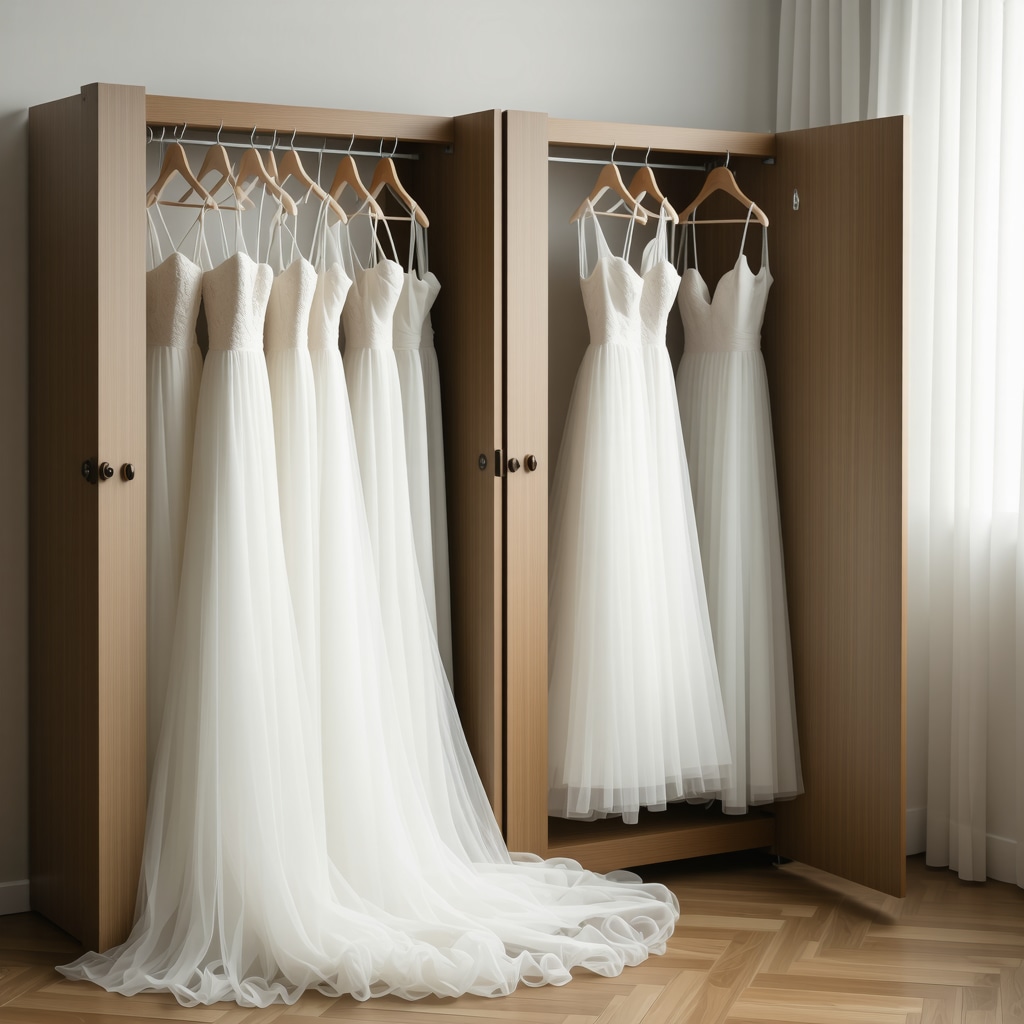Innovative Approaches to Wedding Dress Preservation in Wiregrass
Wedding dress preservation is an intricate discipline combining textile conservation science with practical storage solutions. For brides in the Wiregrass region, where humidity and temperature fluctuations pose unique challenges, selecting appropriate preservation boxes is essential to maintain the longevity and pristine condition of cherished bridal gowns. Preservation boxes act as critical barriers against environmental contaminants, light exposure, and biological degradation, thus safeguarding the fabric’s structural integrity and aesthetic allure for decades.
Material Science Behind Effective Preservation Boxes
Advanced preservation boxes designed for wedding gowns utilize acid-free, lignin-free archival quality materials that minimize chemical interactions with delicate fabrics like silk, satin, and tulle. These boxes often incorporate inert polyethylene or polypropylene linings that provide a moisture-stable microenvironment crucial for preventing mold and mildew growth common in subtropical climates such as Wiregrass. Moreover, boxes with breathable cotton or muslin wraps inside enhance air circulation while protecting against dust and UV damage, ensuring a balanced preservation ecosystem.
What Are the Key Environmental Controls Embedded in Preservation Boxes for Wiregrass Brides?
Environmental control is paramount in the design of preservation boxes for wedding gowns, especially in regions like Wiregrass with high humidity and temperature variability. Effective boxes integrate desiccant packets or silica gel inserts to absorb residual moisture and prevent hydrolytic fiber breakdown. Additionally, UV-resistant coatings or double-layered box walls help filter harmful light wavelengths that accelerate fabric discoloration. The box’s structural design also favors flat storage to avoid stress points, creases, or distortion, maintaining the gown’s original silhouette over time.
Expert Techniques for Long-Term Bridal Gown Protection
Professional preservation services in Wiregrass emphasize a multi-step approach starting with meticulous post-wedding cleaning to eliminate oils, stains, and residues that compromise fabric longevity. Once cleaned, gowns are carefully wrapped in acid-free tissue and placed in specialized preservation boxes tailored to the dress’s dimensions. Industry leaders recommend periodic inspection every 3-5 years to monitor for environmental damage or insect infestation, which is consistent with protocols outlined by the American Institute for Conservation (AIC). Such vigilance ensures early intervention and maintains the gown’s museum-quality condition.
Integrating Wiregrass Preservation Solutions with Sustainable Practices
Given increasing environmental awareness, Wiregrass brides are encouraged to explore eco-conscious preservation boxes that utilize recycled and biodegradable materials without sacrificing protective performance. This aligns with sustainable textile conservation trends, reducing ecological footprints while upholding expert standards in gown care. For comprehensive guidance on eco-friendly bridal dress care, consult resources like Eco-Friendly Wedding Dress Care in New Tampa, FL.
Call to Action: Share Your Expertise and Discover In-Depth Preservation Insights
If you are a bridal expert or textile conservator in the Wiregrass area, we invite you to contribute your advanced preservation techniques to our community. Explore our detailed Best Bridal Gown Preservation in Wiregrass Area 2024 Guide to deepen your understanding and engage with fellow professionals dedicated to excellence in wedding dress care.
Innovative Climate-Adaptive Preservation Methods for Wiregrass Brides
In the Wiregrass region, where subtropical humidity and temperature swings can accelerate fabric degradation, preservation specialists are adopting climate-adaptive solutions that go beyond traditional storage boxes. These include microclimate-controlled enclosures integrating phase change materials (PCMs) that stabilize temperature and relative humidity within the storage environment. By buffering against external fluctuations, PCMs help maintain the gown’s integrity, particularly for delicate fabrics like silk charmeuse or antique lace often favored by discerning brides. This approach represents a leap forward in bridal gown conservation, merging textile science with environmental engineering.
Balancing Preservation and Sustainability: Are Eco-Friendly Materials the Future of Bridal Gown Care?
As awareness of environmental impact grows, Wiregrass brides and preservation experts are questioning how to best balance long-term gown protection with sustainable practices. The shift towards preservation boxes crafted from recycled or biodegradable materials challenges the conventional reliance on synthetic polymers. However, ensuring these eco-friendly materials provide equivalent moisture and light protection remains a critical research focus. Expert collaboration between conservators and material scientists is essential to validate new solutions without compromising fabric longevity.
How Can Emerging Technologies in Textile Conservation Revolutionize Wedding Dress Preservation?
Emerging textile conservation technologies, such as nanotechnology-based coatings and smart humidity sensors, offer promising avenues for enhancing wedding dress preservation. Nanocoatings can impart hydrophobic and antimicrobial properties to gown surfaces, reducing mold risk and moisture absorption without altering fabric texture or appearance. Meanwhile, smart sensors embedded within preservation boxes provide real-time monitoring of environmental conditions, enabling proactive interventions before damage occurs. These innovations exemplify how marrying technology with traditional conservation expertise can safeguard bridal gowns for generations.
For further reading on state-of-the-art preservation techniques and expert cleaning advice, consider exploring our comprehensive coverage of Expert Wedding Dress Cleaning Services in Tampa 2025.
The Role of Professional Expertise in Ensuring Museum-Quality Preservation
While advanced materials and technologies are vital, the discerning eye and skill of professional conservators remain irreplaceable. Experts trained in fiber analysis and historical garment care apply customized cleaning protocols and preservation workflows tailored to each dress’s unique characteristics. They also educate brides on proper handling and storage at home, extending the preservation impact. According to the American Institute for Conservation (AIC), such hands-on expertise is the cornerstone of maintaining museum-quality condition in heirloom bridal gowns.
Engage With Our Community: Share Your Preservation Experiences and Learn More
We encourage bridal professionals, textile conservators, and brides in Wiregrass to share their innovative preservation experiences and challenges. Your insights enrich our collective knowledge and help drive forward best practices in wedding dress care. Join the conversation and deepen your expertise by visiting our detailed Best Bridal Gown Preservation in Wiregrass Area 2024 Guide. Your participation helps foster a community dedicated to preserving these treasured symbols of love and commitment.
Harnessing Nanotechnology and Smart Sensors: The Future of Bridal Gown Preservation
The integration of nanotechnology into textile conservation marks a revolutionary leap for bridal gown preservation, especially in challenging climates like Wiregrass. Nanocoatings, engineered at the molecular level, provide hydrophobic and antimicrobial properties that shield fabrics from moisture-induced damage and microbial colonization without compromising tactile or visual qualities. This delicate balance is critical for preserving the fine textures of silk, lace, and organza. Moreover, embedding smart humidity and temperature sensors within preservation boxes allows for continuous, real-time monitoring of microenvironmental conditions, facilitating immediate corrective actions before irreversible degradation occurs. These technologies collectively create a dynamic preservation system that adapts proactively to environmental stressors, setting new standards for heirloom textile care.
Can Smart Preservation Systems Effectively Replace Traditional Expert Oversight in Wedding Dress Conservation?
While smart preservation systems equipped with sensor networks provide invaluable data and early warnings, they are not substitutes for expert conservator intervention. The nuanced understanding of fiber composition, historical fabric treatments, and stain chemistry requires professional assessment to interpret sensor data meaningfully and implement tailored conservation measures. According to the American Institute for Conservation (AIC), these technologies serve as complementary tools enhancing, rather than replacing, skilled conservators’ judgment. The fusion of human expertise with advanced monitoring technology ensures a holistic approach to preservation, maximizing gown longevity in environments like Wiregrass where climatic extremes complicate conservation efforts.

Microclimate Engineering: Tailoring Preservation to Wiregrass’s Unique Environmental Challenges
Microclimate engineering within preservation enclosures is emerging as a cutting-edge solution to address Wiregrass’s fluctuating humidity and temperature. By incorporating phase change materials (PCMs) that absorb or release latent heat during temperature swings, preservation boxes maintain a more constant internal climate, significantly reducing mechanical stress on fibers caused by expansion and contraction. This method, combined with activated silica gels and breathable archival wraps, orchestrates a multi-layered defense mechanism against environmental degradation. These innovations underscore the importance of integrating environmental engineering principles with textile science to devise preservation solutions that are both reactive and preventive.
Advanced Cleaning Protocols: Balancing Fabric Integrity with Stain Removal Efficacy
Post-wedding cleaning remains a pivotal step in the preservation workflow, yet the complexity of fabric blends and embellishments demands sophisticated cleaning protocols. Enzymatic detergents selectively target organic residues like sweat and oils without harsh chemical exposure, preserving delicate embroidery and beadwork. Moreover, the application of low-impact ultrasonic cleaning techniques has shown promise in dislodging particulate matter embedded deep within fiber matrices without mechanical abrasion. Such methods require precise calibration and expert handling to avoid unintended fiber damage, emphasizing the critical role of conservator expertise in ensuring fabric integrity throughout the cleaning process.
Collaborative Research: Bridging Material Science and Textile Conservation for Sustainable Preservation
Ongoing collaborative research initiatives between material scientists and textile conservators are pivotal in developing preservation materials that marry eco-friendliness with superior protective properties. Novel bio-based polymers derived from renewable resources are under investigation for their potential to replace synthetic liners and wraps, aiming to reduce environmental impact while maintaining archival quality. This interdisciplinary approach fosters innovation in sustainable bridal gown care, addressing both conservation efficacy and ecological responsibility. For brides and conservators eager to stay abreast of these developments, participation in professional networks and symposiums such as the Textile Society of America (TSA) offers invaluable insights and collaboration opportunities.
Invitation to Engage: Elevate Your Preservation Expertise and Join Cutting-Edge Discussions
We invite preservation professionals, bridal experts, and dedicated brides in the Wiregrass region to contribute their specialized knowledge and innovative experiences to our growing community. Your participation enriches the collective understanding and drives the evolution of best practices in wedding dress conservation. Delve deeper into advanced preservation methodologies by exploring our Best Bridal Gown Preservation in Wiregrass Area 2024 Guide. Join the dialogue that shapes the future of bridal gown preservation, ensuring these treasured garments endure beautifully for generations to come.
Integrating Nanotechnology with Environmental Controls for Superior Gown Longevity
The advent of nanotechnology in textile conservation represents a paradigm shift in wedding dress preservation, particularly for the climate challenges faced in Wiregrass. Nanocoatings engineered at the molecular scale impart superhydrophobic and antimicrobial properties to delicate fabrics such as silk charmeuse and antique lace, effectively mitigating moisture ingress and microbial colonization without compromising fabric hand or visual appeal. These coatings act synergistically with embedded smart humidity and temperature sensors, creating an intelligent preservation microenvironment that dynamically responds to environmental fluctuations.
Microclimate Engineering: Precision Climate Stabilization Tailored to Regional Variability
Addressing Wiregrass’s pronounced diurnal humidity and temperature swings, microclimate engineering employs phase change materials (PCMs) within preservation enclosures to buffer against external climate volatility. PCMs absorb latent heat during temperature peaks and release it during drops, stabilizing internal conditions and minimizing mechanical stress on gown fibers. When combined with activated silica gel desiccants and breathable archival wraps, this multilayered system orchestrates a finely tuned climate that extends fabric longevity and maintains aesthetic integrity.
How Do Smart Preservation Systems Enhance Preventative Conservation Without Replacing Expert Intervention?
While smart preservation systems offer real-time environmental monitoring and early detection of adverse conditions, they are designed to complement rather than substitute expert conservator oversight. Experts analyze sensor data within the context of fiber chemistry, historical fabric treatments, and stain pathology to devise bespoke conservation strategies. The American Institute for Conservation (AIC) emphasizes that such technological tools augment professional judgment, enabling proactive interventions that preserve gown integrity in demanding climates like Wiregrass.
Sustainable Innovations: Bio-Based Polymers in Archival Materials
Cutting-edge research in bio-based polymers derived from renewable resources offers promising alternatives to traditional synthetic liners and wraps. These novel materials combine archival-grade protective qualities with biodegradability, addressing Wiregrass brides’ growing environmental concerns without sacrificing performance. Interdisciplinary collaboration between material scientists and textile conservators is essential to validate these innovations, ensuring they meet stringent preservation standards while minimizing ecological footprints.
Invitation to Collaborate: Elevate Your Expertise and Join the Preservation Vanguard
We invite bridal conservators, material scientists, and preservation professionals in Wiregrass to contribute insights and pioneering techniques to our knowledge exchange. Engage with the latest advancements by exploring our comprehensive Best Bridal Gown Preservation in Wiregrass Area 2024 Guide. Join our community to shape the future of wedding dress conservation with an expert blend of science, technology, and sustainable practice.

Expert Insights & Advanced Considerations
Innovative Microclimate Engineering Enhances Preservation Efficacy
Integrating phase change materials (PCMs) within preservation boxes offers a transformative approach to stabilizing temperature and humidity fluctuations endemic to the Wiregrass region. This precision climate control mitigates mechanical fiber stress and hydrolytic degradation, significantly extending the lifespan of delicate bridal fabrics such as silk charmeuse and antique lace. Preservation strategies embracing microclimate engineering exemplify cutting-edge textile conservation tailored to regional environmental challenges.
Nanotechnology Coatings Provide Superior Fabric Protection Without Compromise
Nanocoatings designed at the molecular scale impart hydrophobic and antimicrobial properties to wedding gowns, reducing moisture ingress and microbial colonization without altering fabric hand or appearance. This advancement represents a paradigm shift in preservation, enabling gowns to maintain their pristine condition in subtropical climates while preserving tactile and visual integrity crucial for heirloom textiles.
Smart Sensors Complement But Do Not Replace Expert Conservator Judgment
While embedded humidity and temperature sensors provide invaluable real-time monitoring and early warning capabilities, they function best as adjuncts to expert conservators’ nuanced assessments. Skilled professionals interpret sensor data in the context of fiber chemistry and historical treatments to tailor proactive interventions. This synergy between technology and expertise ensures optimal preservation outcomes in complex environments like Wiregrass.
Eco-Conscious Materials Are the Future, Pending Validation
The shift towards archival materials derived from recycled or bio-based polymers aligns preservation practices with sustainability goals. However, rigorous interdisciplinary research is essential to confirm that these eco-friendly alternatives deliver comparable protection against moisture, light, and biological threats. Collaboration between material scientists and textile conservators is critical to evolving bridal gown preservation without compromising fabric longevity or environmental responsibility.
Curated Expert Resources
- American Institute for Conservation (AIC) – A leading authority offering comprehensive guidelines on textile conservation and preservation ethics, invaluable for understanding professional standards and nuanced care protocols.
- Textile Society of America (TSA) – Provides cutting-edge research, symposiums, and publications bridging material science and textile conservation, fostering interdisciplinary innovation relevant to sustainable preservation.
- Eco-Friendly Wedding Dress Care in New Tampa, FL (link) – A practical resource detailing environmentally responsible bridal gown care methods suited for subtropical climates, emphasizing green materials and processes.
- Expert Wedding Dress Cleaning Services in Tampa 2025 (link) – Showcases advanced cleaning technologies and protocols balancing stain removal efficacy with fabric integrity, crucial for effective post-wedding gown preservation.
- Best Bridal Gown Preservation in Wiregrass Area 2024 Guide (link) – An authoritative regional compendium of local expert techniques, climate-specific solutions, and preservation innovations tailored to Wiregrass brides.
Final Expert Perspective
Wedding dress preservation in the Wiregrass area demands a sophisticated blend of advanced materials science, environmental engineering, and professional expertise. Microclimate stabilization through PCMs, nanotechnology-enhanced coatings, and smart sensor integration collectively elevate preservation outcomes beyond traditional methods. Yet, these innovations must harmonize with the irreplaceable judgment of skilled conservators who interpret nuanced fabric characteristics and historical contexts. Concurrently, the emerging focus on sustainability invites ongoing interdisciplinary collaboration to validate eco-friendly archival materials without sacrificing protective performance. For those committed to safeguarding bridal gowns as cherished heirlooms, engaging with specialized resources like the Best Bridal Gown Preservation in Wiregrass Area 2024 Guide offers invaluable knowledge. We encourage preservation professionals, bridal experts, and conscientious brides alike to contribute their insights and partake in advancing this vital field, ensuring these treasured garments endure with museum-quality excellence for generations to come.

